Why the American overdose epidemic is primarily affecting white people
Racial stereotypes may be playing a role in the US opioid overdose epidemic
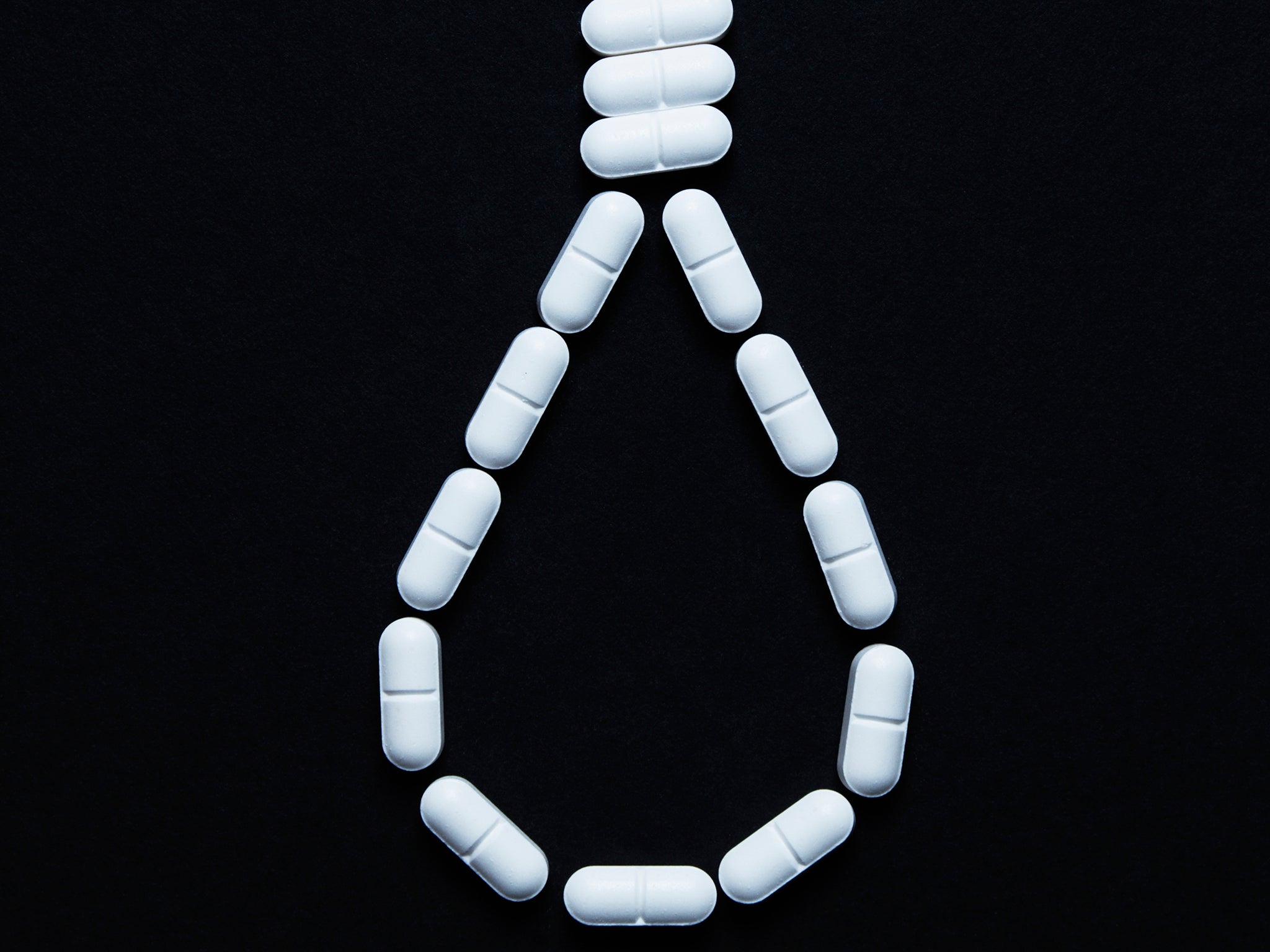
Your support helps us to tell the story
From reproductive rights to climate change to Big Tech, The Independent is on the ground when the story is developing. Whether it's investigating the financials of Elon Musk's pro-Trump PAC or producing our latest documentary, 'The A Word', which shines a light on the American women fighting for reproductive rights, we know how important it is to parse out the facts from the messaging.
At such a critical moment in US history, we need reporters on the ground. Your donation allows us to keep sending journalists to speak to both sides of the story.
The Independent is trusted by Americans across the entire political spectrum. And unlike many other quality news outlets, we choose not to lock Americans out of our reporting and analysis with paywalls. We believe quality journalism should be available to everyone, paid for by those who can afford it.
Your support makes all the difference.Racial stereotypes may be playing a role in the US opioid overdose epidemic, according to a leading expert on opioid addiction.
The rate of white Americans dying annually from drug overdoses has roughly doubled from 2002 to 2014, while the rate of black Americans and Hispanics who die from drug overdoses has remained almost unchanged over that same time frame, according to recently released data from the CDC.
Dr. Andrew Kolodny, the chief medical officer for The Phoenix House and a leading expert on opioid addiction, told Business Insider these trends might have a direct connection to some doctors allowing racist stereotypes to influence the way they prescribe opioid pain killers.
"What's happening is we're overexposing whites to prescription opioids," he said. "Doctors prescribe narcotics more cautiously to black patients. It appeared the doctor may be more worried about addiction or diversion of the pills onto the black market if the patient was black and if the patient is white, they're overprescribing."
While it's impossible to know doctors' reasons for prescribing certain medications — and individual doctors of course vary significantly in their background and world view — studies have shown that some doctors are less likely to prescribe opioid painkillers to black patients, while other research has suggested that black patients may be less likely to report serious pain.
A 2003 study in The American Journal of Public Health found that opioid painkillers were far less likely to be prescribed to black patients than to whites for migraines or back pain. And a 2013 study from the journal Pediatrics found that black patients were much less likely than white patients to be prescribed those painkillers for abdominal pain.
A 2011 study from the journal Clinical Orthopedics and Related Research noted that some black patients may underreport the severity of their pain. Still, the study acknowledged that physicians were a major contributor to the racial disparities in the way pain is treated, "reflect[ing] limited awareness of their own cultural beliefs and stereotypes regarding pain, minority individuals, and use of narcotic analgesics."
Whatever the causes of the disparity, it's clear far more white people are dying from opioid overdoses today.
White Americans of all ages are about twice as likely to die from a drug overdose as black Americans, and four times as likely to die of a drug overdose as Hispanics, based on the CDC data from 2014. These drug overdoses are mostly due to opioid addiction from both prescription pain killers and heroin.
Broken down by certain age groups, the data is even more staggering.
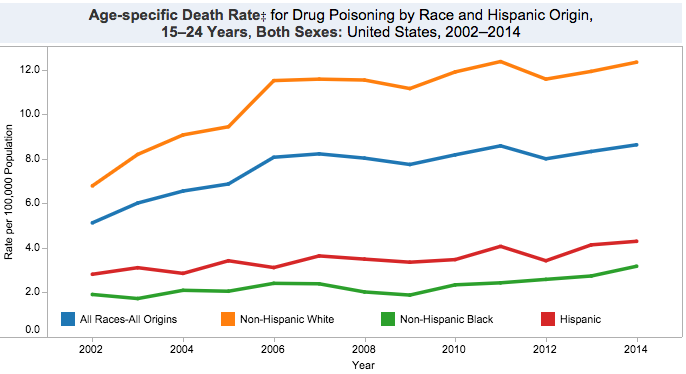
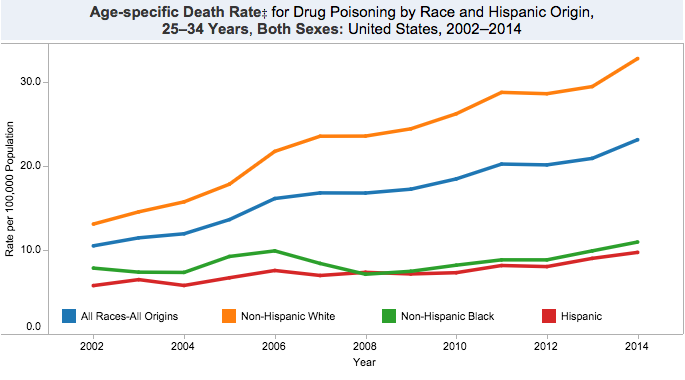
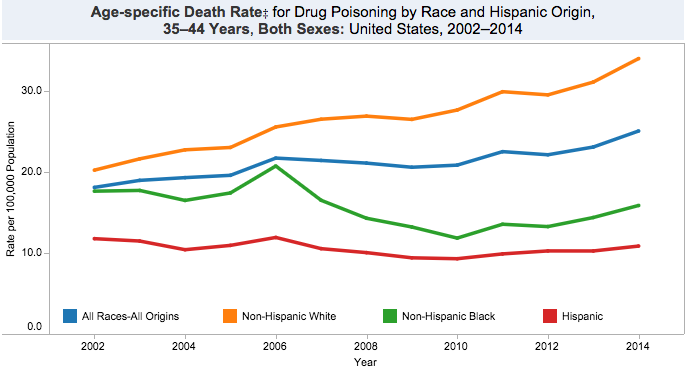
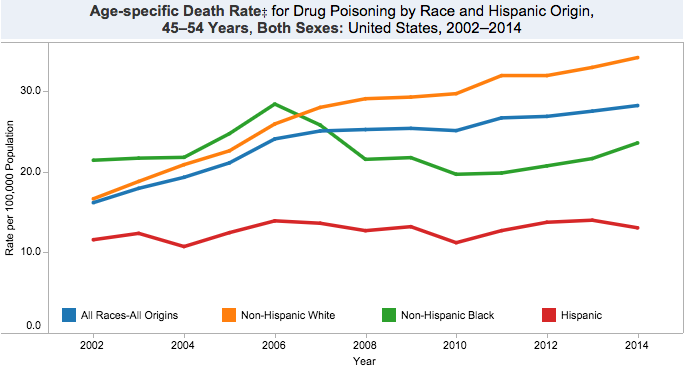

In 2014, white Americans between the age of 25-34 were dying by overdose at a rate that's roughly three times what it was in 2002, while the death rate for black Americans and Hispanics went relatively unchanged over that 12-year period.
White Americans between 15 and 24 years old were roughly six times more likely to die from a drug overdose in 2014 than black Americans and about four times as likely to die than Hispanics.
For white Americans between the age of 35 and 44 as well as between 45 and 54, a large uptick in the death rate from drug overdoses was also experienced between 2002 and 2014. Meanwhile, the rate of drug overdose deaths for black Americans and Hispanics remained unchanged.
"I think very often, there's this idea [addicts are] likely to be poor and non-white and engaged in a criminal subculture," Kolodny said. "I think there's this perception that addicts are born bad. There's this subset of our population that is just going to be addicts, they'll get their hands on whatever drugs they can. I don't think there's an appreciation of the fact that addiction can be caused by repeated exposure to a highly addictive drug."
More than 47,000 people died of drug overdoses in 2014, per the CDC.
Read more:
• Venture capital analyst: '2016 will be the year of rabbits'
• French taxi drivers shut down Paris as protests over Uber turn violent
• Credit Suisse : Oil still hasn't hit bottom
Read the original article on Business Insider UK. © 2015. Follow Business Insider UK on Twitter.
Join our commenting forum
Join thought-provoking conversations, follow other Independent readers and see their replies
Comments